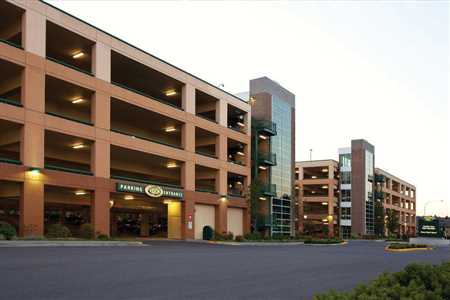

In modern architecture, sustainability and performance stand as pivotal elements that shape design concepts. This trend is increasingly prominent in hospitality establishments, where a balance between aesthetics and functionality is essential. An exceptional instance of this movement can be found in a unique project that emphasizes a commitment to environmental responsibility while enhancing overall guest experience.
This remarkable initiative showcases a progressive technique aimed at optimizing thermal comfort and reducing resource consumption. By integrating advanced materials and methodologies, the project addresses contemporary challenges within construction, making strides toward a greener future. Moreover, this endeavor not only elevates visual appeal but also promotes benefits that extend beyond mere aesthetics.
As communities seek innovative paths to sustainability, this exemplary case serves as inspiration. It highlights the importance of choosing materials that align with a vision for an environmentally conscious tomorrow, demonstrating that luxury and responsibility can harmoniously coexist in architectural ventures.
The implementation of advanced materials and techniques has transformed the architectural landscape, enhancing both aesthetics and functionality. Modern approaches not only elevate visual appeal but also significantly contribute to sustainability and thermal performance.
High-Performance Insulation: Utilization of state-of-the-art insulating materials reduces heat transfer, promoting energy conservation.
Smart Ventilation Systems: Innovative designs integrate natural airflow mechanisms, minimizing reliance on artificial temperature controls.
Adaptive Skin Technology: Exterior surfaces are engineered to respond to environmental changes, optimizing energy consumption throughout various weather conditions.
Recycled Materials: Use of upcycled substances not only lowers environmental impact but also enhances durability and resilience.
These cutting-edge techniques ensure a harmonious balance between comfort and ecological responsibility, redefining modern architectural standards.
Innovative substances are redefining insulation practices, leading to improved thermal performance and comfort in modern constructions. These materials offer superior capabilities that address both building efficiency and environmental sustainability.
Among the remarkable choices available are:
Spray Foam Insulation: This versatile option expands to fill cavities, creating a seamless barrier against air leakage and enhancing thermal resistance.
Rigid Foam Boards: These panels provide high insulation values with minimal thickness, making them ideal for various applications, including wall and roof insulation.
Fiberglass Insulation: A classic choice that utilizes trapped air in a mat of glass fibers, offering effective thermal regulation and fire resistance.
Reflective or Radiant Barriers: Positioned in attics or roofs, these materials reflect radiant heat away, optimizing temperature control in sunny climates.
Utilizing advanced insulating components not only improves energy conservation but also contributes to the overall comfort and performance of buildings. The thoughtful integration of these materials creates an environment that efficiently manages temperature variations while reducing energy consumption.
Incorporating such innovations leads to significant benefits, including:
Lower utility costs by minimizing heating and cooling needs.
Enhanced occupant comfort through consistent temperatures.
Improved acoustic performance by reducing noise transmission.
Positive impact on the environment by lowering carbon footprint through efficient design.
Ultimately, selecting appropriate materials ensures an optimized living and working space, fostering a sustainable future for building practices.
Modern thermal protection technology plays a crucial role in enhancing overall comfort and reducing operational costs within buildings. This innovative approach to insulation provides a plethora of advantages that extend beyond mere temperature control.
One of the primary benefits is significant energy conservation. Advanced materials enhance heat retention during winter months and prevent excessive heat accumulation during summer. This not only promotes a more stable indoor climate but also leads to reduced reliance on heating and cooling systems, ultimately resulting in lower utility bills.
Sustainability is another vital aspect. By minimizing energy consumption, state-of-the-art insulation materials contribute to a smaller carbon footprint. This environmentally friendly approach aligns with contemporary standards for sustainable construction and building management.
Moreover, effective insulation materials enhance acoustic performance. This ensures that sound transmission is minimized between spaces, offering a more serene and productive environment for occupants.
Additionally, the durability of advanced insulation solutions ensures long-lasting performance with minimal maintenance. This longevity contributes to the overall return on investment, making it a wise choice for property developers and owners.
Incorporating cutting-edge insulation significantly elevates the quality of living and working environments while promoting responsible resource use. The multitude of advantages offered by these advanced systems makes them an essential consideration for any modern construction or renovation project.
In the context of modern construction, the implementation of advanced exterior materials plays a crucial role in optimizing sustainability. By enhancing insulation properties and reducing thermal bridging, these innovations contribute significantly to minimizing energy consumption in buildings.
One of the primary advantages of adopting such materials is their ability to regulate indoor temperatures, leading to decreased reliance on heating and cooling systems. This not only results in lower operational costs but also promotes environmental sustainability by reducing greenhouse gas emissions.
Furthermore, the incorporation of reflective surfaces can help in mitigating heat absorption during warmer months, creating a more comfortable climate for occupants. The cumulative effect of these features contributes to a more resilient and eco-friendly infrastructure.
The longevity and robustness of exterior materials play a crucial role in ensuring structures withstand various environmental challenges. In regions facing unpredictable weather patterns, it becomes essential to select components that offer superior protection against the elements.
Durability is a key characteristic, reflecting how well materials endure wear, pressure, and various stresses over time. When properly chosen, these components resist deterioration, providing a long-lasting facade that maintains its aesthetic appeal. Weather resistance, on the other hand, indicates a product’s capacity to withstand harsh conditions such as heavy rain, strong winds, and extreme temperature fluctuations, safeguarding the integrity of the building.
Materials designed with high durability and excellent weather resistance contribute not only to structural stability but also to reduced maintenance needs, ultimately enhancing the building’s overall efficiency and lifespan. Thus, investing in top-tier options ensures that the investment remains protected, functional, and visually striking throughout its use.

Ensuring durability and longevity in architectural exteriors is essential for sustained value and efficacy. A well-considered approach to maintenance not only extends lifespan but also enhances aesthetic appeal over time. Regular inspections and proactive upkeep are critical components of this strategy, allowing for timely interventions that preserve overall integrity.
Properly selected materials contribute significantly to performance metrics. Resistance to environmental factors, such as moisture and temperature fluctuations, can make a marked difference in maintenance frequency and costs. This section highlights key practices and considerations for maintaining high standards in external design.
Awareness of industry standards for maintenance can empower stakeholders to prioritize timely actions that uphold structural performance. Implementing a comprehensive maintenance plan not only tracks condition metrics but also optimizes overall investment in building longevity.
When it comes to safeguarding structures from unpredictable and severe climate challenges, selecting the right exterior material is essential. A durable facade not only enhances aesthetic appeal but also serves as a robust barrier against rain, wind, and fluctuating temperatures. This approach ensures longevity and comfort for occupants by minimizing the impact of environmental elements.
Resilience is a key characteristic of advanced materials designed for exterior use. Such components are engineered to withstand extreme conditions, providing essential support during storms or heavy precipitation. This fortification helps mitigate risks associated with water damage and wind intrusion, ultimately protecting the structural integrity.
Additionally, the ability to maintain a stable internal environment is crucial. High-quality exterior materials contribute to energy conservation, which reduces the strain on heating and cooling systems. This feature is particularly beneficial in regions prone to temperature fluctuations, enabling a consistent and comfortable atmosphere indoors.
Overall, investing in superior protective materials enhances not only safety but also the resilience of structures against the elements. With the right choice, facilities can thrive, providing comfort and safety for all who enter.
Implementing advanced building materials contributes significantly to reducing ecological footprints and promoting long-lasting practices. By focusing on sustainable choices, structures can minimize their impact on natural resources while enhancing aesthetic value and functionality.
Utilization of renewable resources plays a crucial role in modern construction endeavors. By selecting materials sourced from sustainable suppliers, projects can support responsible forestry practices and reduce dependency on non-renewable options.
Additionally, energy conservation measures integrated into building design can lead to lower operational costs. Enhanced insulation and weatherproofing help maintain comfortable indoor climates, reducing the need for heating and cooling systems, thus lessening energy consumption.
Another key advantage lies in waste reduction. Using sustainable construction materials often results in less waste during production and installation. This responsible approach not only contributes to environmental sustainability but also promotes economic savings by minimizing disposal costs.
Moreover, projects that prioritize ecological integrity often yield higher property values and attract environmentally conscious occupants. By fostering a commitment to sustainability, developers can create spaces that resonate with the growing demand for green living solutions.
In modern construction, selecting sustainable components plays a crucial role in minimizing environmental impact while enhancing overall performance. By prioritizing responsible sourcing and production methods, buildings can ensure a healthier future for our planet.
Recycled materials present an excellent option, significantly reducing waste and utilizing resources that would otherwise be discarded. Incorporating these elements not only lowers carbon footprints but also contributes to the circular economy.
Another noteworthy choice includes natural fibers, harvested from renewable sources. These materials typically require less energy in their production process and often provide superior insulation properties, leading to a more comfortable indoor environment.
Moreover, locally sourced products minimize transportation emissions, supporting regional economies while lowering energy consumption associated with long-distance shipping. This alignment with environmental stewardship is essential for promoting sustainable development practices.
Overall, adopting eco-friendly material options leads to innovative design solutions that harmonize with nature, benefiting both inhabitants and the ecosystem.